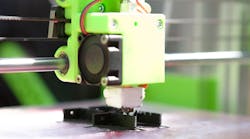The additive manufacturing world’s big news in 2023—the merger between Stratasys, the No.1 additive company (based on 2022 revenues) and Desktop Metal, the No. 4 company—turned into a nothingburger after 3D Systems, the second-largest producer in the industry, put in an offer to purchase Stratasys. Corporate machinations ensued, and Stratasys shareholders eventually voted to put the kibosh on the deal.
While the merger didn’t take place, conversations leading up to the fateful vote with Stratasys CEO Yoav Zeif and Desktop Metal founder and CEO Ric Fulop generated insights as to whether or not additive companies actually turn profits and what “at scale” means for the technology.
That flurry of corporate maneuvering in the additive manufacturing world may continue in 2024 with Nano Dimension's renewed bid for Stratasys. And, the existential questions about the future of the technology will linger. Here’s what we expect 2024 will contribute to the conversation.
Lay of the Additive Land
“The impact of new developments in AM is almost never like flipping a switch. Most require many years to unfold and mature to full commercialization,” says Terry Wohlers, head of advisory services and market intelligence at Wohlers Associates, part of the ASTM International family of organizations.
Wohlers expects in 2024 to see:
A growing number of companies will consider how they can create and store inventories digitally and then manufacture on-demand to support semi-custom design and manufacturing. Wohlers believes relatively few will succeed in putting it into practice over the next year due to upfront costs and ROI uncertainty.
Organizations will place more importance on the carbon footprint impact of AM. Many will find sustainable products less costly to produce due to the use of less material and improved energy savings during production.
“It is interesting to see new and developing applications of AM. Among them are the 3D printing of medicine, living tissue, fashion designs and furniture. They show the impressive breadth and promise of AM beyond industrial applications. None will move the needle in 2024, but they are important to watch. They could trigger new ideas that may lead to something big in the future,” Wohler adds.
Tackling Supply Chain Challenges with Additive
Paul Miller, vice president and principal analyst at Forrester, believes additive manufacturing will play its part as manufacturers attempt to achieve “Goldilocks manufacturing,” the right balance between offshore, nearshore and onshore manufacturing capability.
“Manufacturers are unlikely to move every factory from low-cost offshore centers to higher-cost locations closer to customers, but additive manufacturing will sometimes offer a cost-effective way to produce some parts and components at (or very near to) the customer’s point of need,” Miller says.
Shai Terem, CEO at Markforged, believes the intersection of manufacturing and the sharing economy may redefine traditional production models and reshape the industrial landscape as a peer-to-peer model.
“Keeping an extensive physical inventory ties up capital in parts that may go untouched for years. The ability to transform parts into collaborative production hubs will pave the way for the future of distributed manufacturing. This involves integrating 3D printing with a digitized platform, allowing parts to be uploaded and printed at the time and point of need without the need to be manufactured in advance, shipped, and stored until needed,” Terem says.
Dale Tutt, vice president of industry strategy, Siemens Digital Industries Software thinks sustainability benefits will increase additive’s supply chain utility.
“Instead of doing a lot of subtractive machining, now companies can print parts, which is a more efficient use of materials while enabling manufacturers to tailor parts to improve the performance of the part. Parts can also be printed closer to where they are needed instead of being centrally manufactured and shipped all over the world, which further reduces the carbon footprint of the product,” Tutt says.
Manufacturers will prioritize installing 3D printers on shop floors in 2024, according to Rich Garrity, chief industrial business officer at Stratasys.
“As we see more reshoring and more plants being developed across the globe that are delivering materials, parts, etc. on a more local level, space on the manufacturing floor will be, and should be a premium. … You have manufacturers who are building additive centers, which will help them with their prototyping, but will also enable them to think about how to put additive into their actual manufacturing processes,” Garrity says.
Tripp Burd, senior manager for strategic application engineering at Markforged, also thinks 2024 will mark an increasing number of shop floor installations for 3D printers.
“By empowering manufacturers and OEM to produce precise components on demand and reducing reliance on traditional manufacturing methods, these cutting-edge solutions will become vital tools in navigating through delays and challenges in the broader supply chain. The convergence of these innovative approaches on the factory floor is essential for ensuring not just the efficiency of production but also the adaptability required in today’s rapidly changing industrial landscape,” says Burd.
Expected Advances in Additive Technology
Finally, software development, not hardware breakthroughs, will likely define advances in additive technology next year.
“Emerging technologies like AI are being leveraged to automate processes for additive manufacturing, including removing barriers to entry to the 3D printing design process and bringing more hyper-personalized and sustainable product designs to life,” says Dave Prezzano, global head of go-to-market, personalization & 3D printing at HP Inc.
“The technology that needs to change is having more automation and artificial intelligence built into the processes. As those technologies become smarter, additive manufacturing will grow in its ability to mass produce parts for the various industries. We made strides this year, but we need to continue that momentum in 2024,” says Rich Garrity, Chief Industrial Business Officer at Stratasys.
New materials development will also proceed apace, improving existing applications and enabling new sorts of products.
“Advancements in multi-material [3D printing] will enable more functional and aesthetic uses across industries. For instance, expansion of composite AM using reinforced plastics and metals to make end-use parts with superior mechanical properties suitable for structural and load-bearing applications,” says Andrew Snow, senior vice president for EOS North America.






